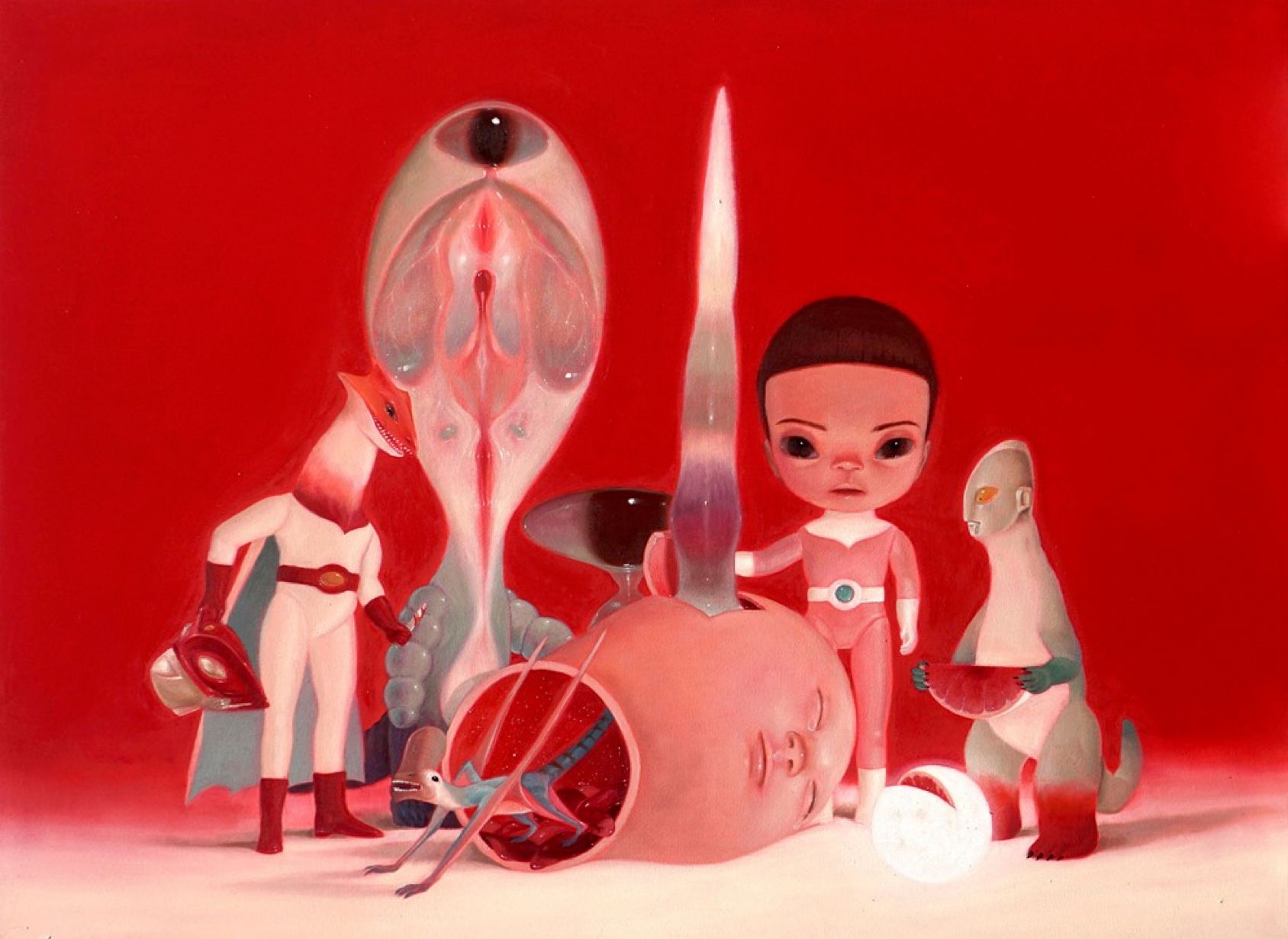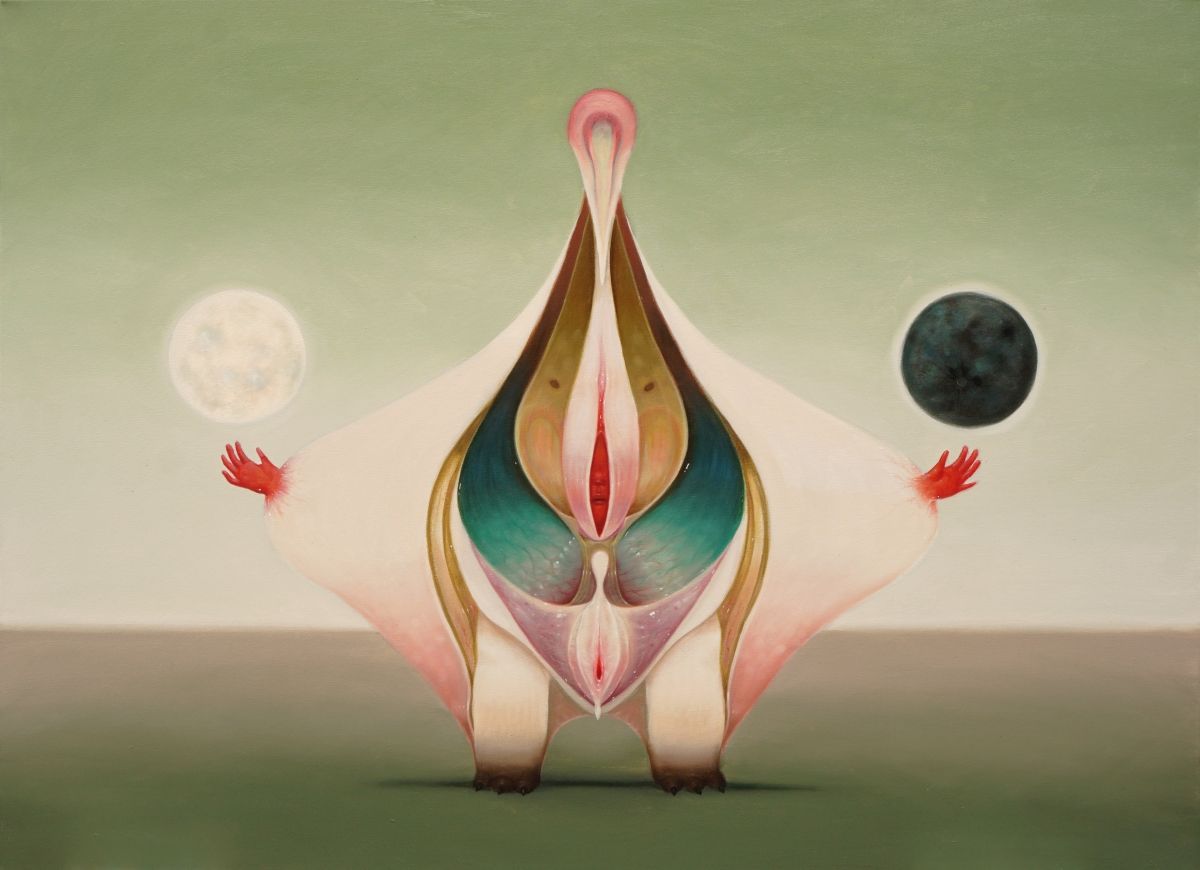
The acclaimed Indonesian artist Roby Dwi Antono is widely known for his depictions of dream-like parallel worlds inhabited by small children, crashed spacecraft, anomalies too bizarre to describe, and animal-human hybrids that have a penchant for peeling back their flesh to reveal internal organs. His paintings stylistically surf genres, such as classical renaissance, pop, lowbrow, anime and surrealism, with an effortless grace that denotes peerless talent, and it is no surprise that he has been exhibited to critical acclaim all over the globe. The mythological dreamscapes for which he is known are incredibly complex and rich in symbolic iconography that spans cultures, and, in the past, they have very often tipped a sci-fi nod to notions of distant future worlds. It’s interesting then that his latest solo show at Almine Rech signals a profound departure from the creations of his past, and, indeed, reflects significant change in his own life, being the first works he has created since the birth of his first child. The paintings in the show 'Tuk' are executed in almost childlike brushstrokes and convey his ever-present emotional connection to the inner child from an entirely new perspective – that of a young father grappling with the joy and anxiety that accompanies the bringing of new life into the world. The title of the exhibition references new-found parenthood via his own childhood experience of creating traditional wells called ‘Beliks’ during drought in order to give birth to a ‘Tuk’ – a life-giving water spring that emerges from the hole that has been dug in the ground. As such, the show explores not only the ways in which Dwi Antono considers the process of art-making as a source of creative sustenance, but also a desire to excavate his own soul to convey his deepest feelings. Here, the artist discusses his love of surrealism, creating souls for dream creatures and devoting himself to spiritual evolution.
Why are you drawn to the surreal and uncanny as an artist, and why have your past works often explored speculative futures?
I feel the poetic nuance, unanswered questions, puzzles and mystical impression of surrealism. I usually imagine the future – things that haven't yet happened, and how they could happen. Temporality and mortality are my favourite issues in surrealism. Time flies. We can’t exactly predict the future. It could be a good thing, or vice versa. Basically, I believe that a human is the accumulation of experience – even the smallest action that we do today can significantly change the future. In that sense, the future should be predictable, but in reality, it is not. The future holds a mysterious side, with many unexpected possibilities that will only become known as time passes. We tend to be anxious about the future, including me – that’s why I always recall my memories in my work.

Why have you so often been inspired to create animal-human hybrids?
Animal nature is inherent in humans. I also see animals as creatures that have characteristics, and that can behave like humans. Both have souls and feelings. Sometimes I get inspiration from my dreams when I sleep. I can’t remember the dream vividly, or represent it accurately after I wake up, but I immediately make a raw sketch of the characters and backgrounds in my dream, so that I don’t forget them. Usually, the characters and settings I dream of are strange shapes, with unusual colours – illogical and abstract. However, it is interesting for me to translate them into visual form. Of course, I add or subtract things according to my imagination, and this process is always exciting to me. It’s like giving a soul to a dream creature.

Much of your previous work has been described as creepy or unsettling – what draws you to explore darkness?
I don’t know exactly why, however I realise that I like juxtaposing scary things and exposed body organs. I am fascinated by how our body organs are connected to each other – how when there is a malfunction in an organ, it will affect the function of another organ – and I am also amazed by how our body can heal itself. Actually, I’m afraid to see blood, wounds, or any sadistic and brutal scenes in movies. I usually just skip that part. On the other hand, I really enjoy painting colours and texture of flesh, vessels, and other organs – these organs have interesting visual characters to me. If you look at it from the conceptual perspective, I have created a series of paintings about autopsies, in which I show the surgery scenes. My Autopsy of Mystery series of paintings talked about empathy, called 'tepo seliro' in Javanese, which is defined as tolerance. Empathy is an attempt to deepen other human feelings in order to have a comprehensive understanding of what others feel. Humans need to look within to understand and reveal the complexity of human feelings. As social beings, humans crave harmonious bounds with each other. However, today I see that empathy is greatly eroded by egoism and individualism.

You’ve described your work as a mirror in which you see yourself - talk to me about that, and the psychological catharsis it provides for you …
The psychological catharsis that is reflected in my works actually helps me feel calmer when completing a piece. Especially for this latest series, in which I have more freedom to stroke my brush, or sometimes directly use my finger or palms to paint, and this method makes me more expressive and free – recalling my childhood memories, when I just drew using my hand freely without thinking about art rules, style, or anything else. Sometimes, the artwork concept makes me reflect on my life values, or the life journey that I have gone through – is this the life that I want, or is it still far from being perfect in terms of being a better person than I was yesterday? I believe that my series of works reflect personal milestones, in that I find it interesting to review each series as part of my reflection or self-criticism. I’m not good at conveying meaning verbally, but I feel free to speak through my painting. It provides psychological catharsis for me.

What is at the core of your latest series of works?
In my hometown around the 90s, there were a lot of villagers who couldn’t afford to install the government clear water providers at their houses, including me. My family used the water from a neighbour’s well to meet daily needs for clean water. Apart from taking water from the well, many people also used the river flow. Our area is crossed by a river called Kali Panjang. We used to wash clothes and bathe in the river. However, when the dry season comes, the well dries up, and the water level decreases, so getting a clean water supply becomes more difficult. To overcome this drought, locals will create artificial springs that are not too wide and quite shallow, so it will be easier for us to take the water. We called this artificial spring ‘Belik’. In the process of making this series for the London show, I reflected upon the process of making Belik and found several interesting activities, which are ‘digging’, ‘draining’, ‘filtering’, ‘settling’, and ‘purifying’. When it comes to my current situation, ‘digging’ refers to how I reflect or look within myself to understand my weaknesses and strengths, and how far I’m prepared to face the future. ‘Draining’ and ‘filtering’ is more about my effort to throw away bad things, or leave bad traits and habits. While ‘settling’ is to remind me to always think before taking action. Lastly, ‘purifying’ is my hope to become a better human being, and be useful to my family and the community around me.
How has fatherhood changed your outlook as an artist and your perspective on life?
Becoming a parent is both exciting and thrilling for me, and this phase has changed my perspective towards life. Previously, I was just full of myself, but now I should be focused not only on myself, but also on my wife and daughter. It is indeed quite tiring carrying out all the roles as a father and husband, but there are always good surprises that happen in my family every day. Since the arrival of my daughter, I have loved watching her grow every second. On the other hand, I am also worried about the bad things that might happen in my family. This encourages me to continue learning and improving myself, while thanking God for everything I have received. It has made me realise that I can’t do everything by myself – I need my partner, my family, and my friends. In short, I’m not alone here.
Tuk exhibits at Almine Rech until February 14th
Images (top to bottom): Portrait of Roby Dwi Antono by Wisnu Aji; KITA, BERTIGA SAJA, Roby Dwi Antono, 2023; Lunar Ritual 1, Roby Dwi Antono, 2023; MENARI; MENTARI, Roby Dwi Antono, 2023; Piteron, Roby Dwi Antono, 2023. All images courtesy of the artist and Almine Rech.